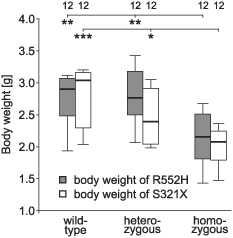The structure of innate vocalizations in Foxp2-deficient mouse pups
- PMID: 20132318
- PMCID: PMC2895353
- DOI: 10.1111/j.1601-183X.2010.00570.x
The structure of innate vocalizations in Foxp2-deficient mouse pups
Abstract
Heterozygous mutations of the human FOXP2 gene are implicated in a severe speech and language disorder. Aetiological mutations of murine Foxp2 yield abnormal synaptic plasticity and impaired motor-skill learning in mutant mice, while knockdown of the avian orthologue in songbirds interferes with auditory-guided vocal learning. Here, we investigate influences of two distinct Foxp2 point mutations on vocalizations of 4-day-old mouse pups (Mus musculus). The R552H missense mutation is identical to that causing speech and language deficits in a large well-studied human family, while the S321X nonsense mutation represents a null allele that does not produce Foxp2 protein. We ask whether vocalizations, based solely on innate mechanisms of production, are affected by these alternative Foxp2 mutations. Sound recordings were taken in two different situations: isolation and distress, eliciting a range of call types, including broadband vocalizations of varying noise content, ultrasonic whistles and clicks. Sound production rates and several acoustic parameters showed that, despite absence of functional Foxp2, homozygous mutants could vocalize all types of sounds in a normal temporal pattern, but only at comparably low intensities. We suggest that altered vocal output of these homozygotes may be secondary to developmental delays and somatic weakness. Heterozygous mutants did not differ from wild-types in any of the measures that we studied (R552H ) or in only a few (S321X ), which were in the range of differences routinely observed for different mouse strains. Thus, Foxp2 is not essential for the innate production of emotional vocalizations with largely normal acoustic properties by mouse pups.
Figures












Similar articles
-
Ultrasonic vocalizations of adult male Foxp2-mutant mice: behavioral contexts of arousal and emotion.Genes Brain Behav. 2016 Feb;15(2):243-59. doi: 10.1111/gbb.12274. Epub 2016 Jan 13. Genes Brain Behav. 2016. PMID: 26566793
-
Modified sound-evoked brainstem potentials in Foxp2 mutant mice.Brain Res. 2009 Sep 15;1289:30-6. doi: 10.1016/j.brainres.2009.06.092. Epub 2009 Jul 9. Brain Res. 2009. PMID: 19596273
-
Impaired synaptic plasticity and motor learning in mice with a point mutation implicated in human speech deficits.Curr Biol. 2008 Mar 11;18(5):354-62. doi: 10.1016/j.cub.2008.01.060. Curr Biol. 2008. PMID: 18328704 Free PMC article.
-
FOXP2 as a molecular window into speech and language.Trends Genet. 2009 Apr;25(4):166-77. doi: 10.1016/j.tig.2009.03.002. Epub 2009 Mar 21. Trends Genet. 2009. PMID: 19304338 Review.
-
From songbird to humans: The multifaceted roles of FOXP2 in speech and motor learning.Neurosci Biobehav Rev. 2024 Dec;167:105936. doi: 10.1016/j.neubiorev.2024.105936. Epub 2024 Nov 6. Neurosci Biobehav Rev. 2024. PMID: 39510218 Review.
Cited by
-
Genetic insights into the functional elements of language.Hum Genet. 2013 Sep;132(9):959-86. doi: 10.1007/s00439-013-1317-0. Epub 2013 Jun 8. Hum Genet. 2013. PMID: 23749164 Review.
-
Ultrasonic vocalization of pup and adult fat-tailed gerbils (Pachyuromys duprasi).PLoS One. 2019 Jul 29;14(7):e0219749. doi: 10.1371/journal.pone.0219749. eCollection 2019. PLoS One. 2019. PMID: 31356642 Free PMC article.
-
Evo-devo, deep homology and FoxP2: implications for the evolution of speech and language.Philos Trans R Soc Lond B Biol Sci. 2011 Jul 27;366(1574):2124-40. doi: 10.1098/rstb.2011.0001. Philos Trans R Soc Lond B Biol Sci. 2011. PMID: 21690130 Free PMC article. Review.
-
Knockout of Foxp2 disrupts vocal development in mice.Sci Rep. 2016 Mar 16;6:23305. doi: 10.1038/srep23305. Sci Rep. 2016. PMID: 26980647 Free PMC article.
-
Loss of Intercalated Cells (ITCs) in the Mouse Amygdala of Tshz1 Mutants Correlates with Fear, Depression, and Social Interaction Phenotypes.J Neurosci. 2018 Jan 31;38(5):1160-1177. doi: 10.1523/JNEUROSCI.1412-17.2017. Epub 2017 Dec 18. J Neurosci. 2018. PMID: 29255003 Free PMC article.
References
-
- Bell RW, Nitschke W, Zachman T. Ultrasounds in three inbred strains of young mice. Behav Biol. 1972;7:805–814. - PubMed
-
- Branchi I, Santucci D, Puopolo M, Alleva E. Neonatal behaviours associated with ultrasonic vocalizations in mice (Mus musculus): a slow-motion analysis. Dev Psychobiol. 2004;44:37–44. - PubMed
-
- Brunelli SA. Selective breeding for an infant phenotype: rat pup ultrasonic vocalization (USV) Behav Genet. 2005;35:53–65. - PubMed
-
- D’Udine B, Robinson DJ, Oliverio A. An analysis of single-gene effects on audible and ultrasonic vocalizations in the mouse. Behav Neural Biol. 1982;36:197–203. - PubMed
Publication types
MeSH terms
Substances
Grants and funding
LinkOut - more resources
Full Text Sources
Medical
Molecular Biology Databases
Miscellaneous

